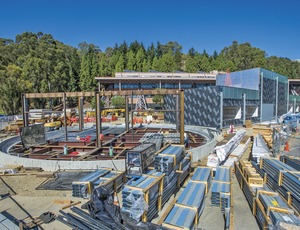

"FLEXLAB came out of 25 years of trying to figure out how things work in the real world," says Selkowitz, leader of the windows and envelope materials group and senior adviser for building science with the U.S. Dept. of Energy's Lawrence Berkeley National Laboratory (LBNL).
Now in the commissioning phase, the $15.7-million lab is the first new user facility of LBNL's building-technologies branch, which Selkowitz led from 1985 to 2011. FLEXLAB is seeking building-sector stakeholders to rent any or all of its four test beds for controlled experiments on integrated building systems. "The integration challenge is fundamentally the biggest obstacle to building energy conservation," says Selkowitz.
For a fee, users can test sensored mock-ups of mini office buildings with interchangeable parts, including exterior walls, windows, shading systems,
 |
| SELKOWITZ |
Selkowitz has been finding ways to save building energy for three decades. "Steve Selkowitz has been an inspiration for green-building researchers and professionals beyond the U.S.," says Stephen Mok, deputy director of research at Singapore's Centre for Sustainable Buildings and Construction. The center, within the Building and Construction Authority led by Newsmaker John Keung, is building Asia's first rotatable test bed, modeled after FLEXLAB (see p. 38).
"One of the amazing things about Steve is that he connects laboratory research to real buildings," says Elizabeth J. Heider, chief sustainability officer for Skanska USA and the 2012 chairwoman of the U.S. Green Building Council's board of directors.
Selkowitz, 65, is pushing toward even more real-world connections. He just kicked off a living-lab demonstration project that, using innovative lighting, daylighting and shading systems installed in New York City office space, will attack the "expectation gap" between predicted and measured building systems performance.
FLEXLAB's first test likely will start in March. Selkowitz says, "We have a handshake agreement with a contractor to test a 300,000-sq-ft office building."
interior lighting and mechanical systems. They also can validate energy models. A long-term goal is to develop accurate energy-use simulation tools to serve as a foundation for contractual energy-performance guarantees.

Post a comment to this article
Report Abusive Comment